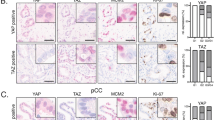Abstract
There is accumulating evidence that hepatocellular carcinomas (HCCs) expressing “stemness”-related markers, e.g., keratin 19 (K19) and epithelial cell adhesion molecule (EpCAM), are associated with aggressive biological behavior. In order to further investigate the molecular characteristics of this subgroup of HCCs, we examined copy number alterations of K19-positive and K19-negative HCCs and found frequent amplifications of the 4p16.3 locus containing the TACC3 gene, which has previously not been described in HCCs. We performed an immunohistochemical analysis of transforming acidic coiled-coil-containing protein 3 (TACC3) expression in HCCs in whole tissue sections and tissue microarrays and examined the clinicopathological characteristics of TACC3-overexpressing HCCs in relation to stemness-related marker (K19, EpCAM) expression, epithelial-mesenchymal transition (EMT)-related proteins, and survival. Cytoplasmic TACC3 protein expression was seen in 7/7 whole tissue sections of K19-positive HCCs, while TACC3 expression was negative or patchy in K19-negative cases. In the tissue microarray cohort, TACC3 was overexpressed in 105/188 (55.9 %) HCCs and was associated with poor differentiation (p = 0.028), major vascular invasion (p = 0.039), higher tumor stages (p = 0.015), younger age (p = 0.003), higher proliferative activity (p < 0.001), and more frequent multipolar mitoses (p < 0.001). TACC3 expression was significantly correlated with K19 (p = 0.010) and EpCAM (p < 0.001) positivity. In addition, TACC3 overexpression was associated with frequent expression of S100A4, uPAR, and ezrin (p < 0.001, all) and loss of E-cadherin expression (p = 0.014), and overall survival was significantly decreased in patients with TACC3-positive HCCs (p = 0.014). In conclusion, TACC3 overexpression was associated with clinicopathological features of aggressiveness, increased EMT-related protein expression, and poor survival, suggesting a potential role for TACC3 as a prognostic biomarker and therapeutic target in HCC.




Similar content being viewed by others
References
Kim H, Park YN. Hepatocellular carcinomas expressing ‘stemness’-related markers: clinicopathological characteristics. Dig Dis. 2014;32:778–85.
Theise ND, Curado MP, Franceschi S, Hytiroglou P, Kudo M, Park YN, et al. Hepatocellular carcinoma. In: Bosman FT, Carneiro F, Hruban RH, Theise ND, editors. WHO classification of tumours of the digestive system. 4th ed. Lyon: IARC; 2010. p. 205–16.
Theise ND, Nakashima O, Park YN, Nakanuma Y. Combined hepatocellular-cholangiocarcinoma. In: Bosman FT, Carneiro F, Hruban RH, Theise ND, editors. WHO classification of tumours of the digestive system. 4th ed. Lyon: IARC; 2010. p. 225–7.
Kim H, Yoo JE, Cho JY, et al. Telomere length, TERT and shelterin complex proteins in hepatocellular carcinomas expressing “stemness”-related markers. J Hepatol. 2013;59:746–52.
Still IH, Vince P, Cowell JK. The third member of the transforming acidic coiled coil-containing gene family, TACC3, maps in 4p16, close to translocation breakpoints in multiple myeloma, and is upregulated in various cancer cell lines. Genomics. 1999;58:165–70.
Gergely F, Kidd D, Jeffers K, Wakefield JG, Raff JW. D-TACC: a novel centrosomal protein required for normal spindle function in the early Drosophila embryo. EMBO J. 2000;19:241–52.
Ha GH, Kim JL, Breuer EK. TACC3 is essential for EGF-mediated EMT in cervical cancer. PLoS One. 2013;8, e70353.
Ha GH, Park JS, Breuer EK. TACC3 promotes epithelial-mesenchymal transition (EMT) through the activation of PI3K/Akt and ERK signaling pathways. Cancer Lett. 2013;332:63–73.
Kim H, Choi GH, Na DC, et al. Human hepatocellular carcinomas with “stemness”-related marker expression: keratin 19 expression and a poor prognosis. Hepatology. 2011;54:1707–17.
Oh BK, Kim H, Park YN, et al. High telomerase activity and long telomeres in advanced hepatocellular carcinomas with poor prognosis. Lab Invest. 2008;88:144–52.
Peset I, Vernos I. The TACC proteins: TACC-ling microtubule dynamics and centrosome function. Trends Cell Biol. 2008;18:379–88.
Hood FE, Royle SJ. Pulling it together: the mitotic function of TACC3. Bioarchitecture. 2011;1:105–9.
Brinkley BR. Managing the centrosome numbers game: from chaos to stability in cancer cell division. Trends Cell Biol. 2001;11:18–21.
Fielding AB, Lim S, Montgomery K, Dobreva I, Dedhar S. A critical role of integrin-linked kinase, ch-TOG and TACC3 in centrosome clustering in cancer cells. Oncogene. 2011;30:521–34.
Ha GH, Kim JL, Petersson A, et al. TACC3 deregulates the DNA damage response and confers sensitivity to radiation and PARP inhibition. Oncogene. 2015;34:1667–78.
Jung CK, Jung JH, Park GS, Lee A, Kang CS, Lee KY. Expression of transforming acidic coiled-coil containing protein 3 is a novel independent prognostic marker in non-small cell lung cancer. Pathol Int. 2006;56:503–9.
Ha GH, Kim JL, Breuer EK. Transforming acidic coiled-coil proteins (TACCs) in human cancer. Cancer Lett. 2013;336:24–33.
Lauffart B, Vaughan MM, Eddy R, et al. Aberrations of TACC1 and TACC3 are associated with ovarian cancer. BMC Womens Health. 2005;5:8.
Duncan CG, Killela PJ, Payne CA, et al. Integrated genomic analyses identify ERRFI1 and TACC3 as glioblastoma-targeted genes. Oncotarget. 2010;1:265–77.
Singh D, Chan JM, Zoppoli P, et al. Transforming fusions of FGFR and TACC genes in human glioblastoma. Science. 2012;337:1231–5.
Williams SV, Hurst CD, Knowles MA. Oncogenic FGFR3 gene fusions in bladder cancer. Hum Mol Genet. 2013;22:795–803.
Borad MJ, Champion MD, Egan JB, et al. Integrated genomic characterization reveals novel, therapeutically relevant drug targets in FGFR and EGFR pathways in sporadic intrahepatic cholangiocarcinoma. PLoS Genet. 2014;10, e1004135.
Schmidt S, Schneider L, Essmann F, et al. The centrosomal protein TACC3 controls paclitaxel sensitivity by modulating a premature senescence program. Oncogene. 2010;29:6184–92.
Acknowledgments
This study was supported by grant number 14-2014-012 from the SNUBH Research Fund and the Basic Science Research Program through NRF funded by the Ministry of Education (2013R1A1A2062320).
Author information
Authors and Affiliations
Corresponding authors
Rights and permissions
About this article
Cite this article
Nahm, J.H., Kim, H., Lee, H. et al. Transforming acidic coiled-coil-containing protein 3 (TACC3) overexpression in hepatocellular carcinomas is associated with “stemness” and epithelial-mesenchymal transition-related marker expression and a poor prognosis. Tumor Biol. 37, 393–403 (2016). https://doi.org/10.1007/s13277-015-3810-7
Received:
Accepted:
Published:
Issue Date:
DOI: https://doi.org/10.1007/s13277-015-3810-7




